ACE依赖性阿尔茨海默病:ACE突变对血液ACE水平影响的进一步评估
IF 4.2
2区 生物学
Q2 BIOCHEMISTRY & MOLECULAR BIOLOGY
Biochimica et biophysica acta. Molecular basis of disease
Pub Date : 2025-03-29
DOI:10.1016/j.bbadis.2025.167817
引用次数: 0
摘要
背景:血管紧张素- i转换酶(ACE)的破坏性突变导致ACE水平低,可能会增加迟发性阿尔茨海默病(AD)的风险。方法/主要发现:我们测量了74名患有12种不同杂合性ACE突变的受试者血浆中edta的ACE水平。使用一组针对ACE和两种ACE底物的单克隆抗体,我们评估了这些突变对ACE表型的影响。我们发现了几个跨越两个ACE结构域的突变,包括最常见的突变Y215C,它显著降低了血液中ACE的水平。因此,这些突变可能是迟发性AD的潜在危险因素。此外,G325R和E738K两种突变也改变了ACE的催化性能。我们还发现某些单克隆抗体与突变ACE的结合可以作为这些和其他ACE突变的标记物。这将使得在潜在的未来治疗中监测血液中突变ACE的命运成为可能,特别是在转运缺陷ACE突变的情况下。通过分子模型研究ACE与淀粉样蛋白β 1-42 (a - β42)的相互作用,预测哪些ACE突变可能影响a - β42水解,从而增加AD发生的风险。结论/意义:对ACE突变患者血液中ACE水平的系统分析有望识别出迟发性AD风险增加的个体。正如先前在转运缺陷ACE突变Q1069R的细胞模型中所证明的那样,影响转运效率的ACE突变患者可能从结合化学和药物伴侣与蛋白酶体抑制剂的治疗策略中获益。本文章由计算机程序翻译,如有差异,请以英文原文为准。
ACE-dependent Alzheimer's disease: Further assessment of the impact of ACE mutations on blood ACE levels
Background
Carriers of damaging mutations in the angiotensin-I-converting enzyme (ACE) that result in low ACE levels may be at increased risk for late-onset Alzheimer's disease (AD).
Methodology/principal findings
We measured blood ACE levels in EDTA-plasma from 74 subjects with 12 different heterozygous ACE mutations. Using a panel of monoclonal antibodies to ACE and two ACE substrates, we assessed the impact of these mutations on ACE phenotypes. We identified several mutations spanning both ACE domains, including the most frequent mutation, Y215C, that significantly reduce blood ACE levels. Therefore, these mutations may serve as potential risk factors for late-onset AD. Additionally, two mutations tested, G325R and E738K, altered ACE catalytic properties. We also found that the binding of certain mAbs to mutant ACEs could serve as markers for these and other ACE mutations. This would enable monitoring the fate of mutant ACEs in the blood during potential future therapies, particularly in the case of transport-deficient ACE mutations. The interaction between ACE and amyloid beta 1–42 (Aβ42) was studied using molecular modeling, which predicts which ACE mutations may influence Aβ42 hydrolysis, and consequently increase the risk of AD development.
Conclusions/significance
Systematic analysis of blood ACE levels in patients with ACE mutations holds promise for identifying individuals at increased risk of late-onset AD. Patients with ACE mutations affecting transport efficiency may potentially benefit from therapeutic strategies combining chemical and pharmacological chaperones with proteasome inhibitors, as demonstrated previously in a cellular model of the transport-deficient ACE mutation Q1069R.
求助全文
通过发布文献求助,成功后即可免费获取论文全文。
去求助
来源期刊
CiteScore
12.30
自引率
0.00%
发文量
218
审稿时长
32 days
期刊介绍:
BBA Molecular Basis of Disease addresses the biochemistry and molecular genetics of disease processes and models of human disease. This journal covers aspects of aging, cancer, metabolic-, neurological-, and immunological-based disease. Manuscripts focused on using animal models to elucidate biochemical and mechanistic insight in each of these conditions, are particularly encouraged. Manuscripts should emphasize the underlying mechanisms of disease pathways and provide novel contributions to the understanding and/or treatment of these disorders. Highly descriptive and method development submissions may be declined without full review. The submission of uninvited reviews to BBA - Molecular Basis of Disease is strongly discouraged, and any such uninvited review should be accompanied by a coverletter outlining the compelling reasons why the review should be considered.

 求助内容:
求助内容: 应助结果提醒方式:
应助结果提醒方式:


